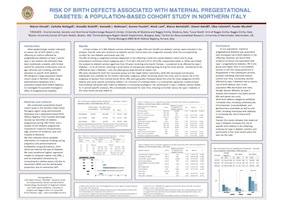Vinceti M, Dennert G, Crespi CM, Zwahlen M, Brinkman M, Zeegers MP, Horneber M, D’Amico R, Del Giovane C.
Cochrane Database Syst Rev. 2014 Mar 30;3:CD005195. PMID: 24683040
Abstract
BACKGROUND:This review is an update of the first Cochrane publ…
Original article: Mercury and selenium intake by seafood from the Ionian Sea: A risk evaluation
Copat C, Vinceti M, D’Agati MG, Arena G, Mauceri V, Grasso A, Fallico R, Sciacca S, Ferrante M.
Ecotoxicol Environ Saf. 2014 Feb;100:87-92. PMID: 24433795
Abstract
The subject of the present study is the evaluation of the concentrations of mercury (…
Poster: Epidemiologia e fattori ambientali di rischio della sclerosi laterale amiotrofica: metodologia di uno studio realizzato in ambiente GIS
La sclerosi laterale amiotrofica (SLA) è la forma più comune di malattia degenerativa dei motoneuroni, caratterizzata da una paralisi progressiva della muscolatura scheletrica e da una prognosi rapidamente infausta. Nonostante l’elevato interesse anche in ambito scientifico nei confronti di questa gravissima patologia, l’eziologia della SLA è ancor oggi purtroppo sostanzialmente ignota, ed in particolare non disponiamo di evidenze convincenti sul possibile ruolo di fattori di rischio ambientali presenti negli ambienti di vita e di lavoro nella sua eziologia.
Poster: Il consumo di legumi riduce il rischio di melanoma – Uno studio caso-controllo nella regione Emilia-Romagna
Introduzione
Vari studi hanno suggerito un ruolo fondamentale delle abitudini alimentari nella eziologia di diversi tumori, tra cui il melanoma cutaneo, neoplasia abitualmente associata soprattutto all’esposizione ai raggi ultravioletti o a fattori ge…
Poster: Risk of birth defects associated with maternal pregestational diabetes: a population-based cohort study in Northern Italy
Most epidemiologic studies indicated an excess risk of birth defect in the offspring of mothers affected by pregestational diabetes of type 1 and/or type 2, but relative risk estimates have been statistically unstable, with limited control for potential confounders such as age, ethnicity and smoking, and little attention to specific birth‐defects. We designed a large population‐based cohort study in Northern Italy, using administrative databases and a population‐based Birth‐Defect Registry, to investigate the possible teratogenic effect of pregestational diabetes.
Original article: Inquinamento da traffico e rischio di malformazioni congenite: considerazioni metodologiche sull’uso di differenti modellistiche espositive
Vinceti M, Malagoli C, Rodolfi R, Cherubini A, Maffeis G, Greco S, Fabbi S, Signorelli C, Storani S, Iacuzio L, Fraulini A, Teggi S, Bergomi M, Astolfi G, Calzolari E, Nicolini F.
Annali di Igiene 2013;25 (Suppl. 1): 509-514
Abstract
The relation be…
Original article: Cerebrospinal fluid of newly diagnosed amyotrophic lateral sclerosis patients exhibits abnormal levels of selenium species including elevated selenite
Vinceti M, Solovyev N, Mandrioli J, Crespi CM, Bonvicini F, Arcolin E, Georgoulopoulou E, Michalke B.
Neurotoxicology. 2013 Sep;38:25-32 PMID: 23732511
Abstract
Exposure to selenium, and particularly to its inorganic forms, has been hypothesized as a risk factor for amyotrophic lateral sclerosis (ALS), a fast progressing motor neuron disease with poorly understood etiology. However, no information is known about levels of inorganic and some organic selenium species in the central nervous system of ALS patients, and recent observations suggest that peripheral biomarkers of exposure are unable to predict these levels for several Se species including the inorganic forms. Using a hospital-referred case-control series and advanced selenium speciation methods, we compared the chemical species of selenium in cerebrospinal fluid from 38 ALS patients to those of 38 reference neurological patients matched on age and gender. We found that higher concentrations of inorganic selenium in the form of selenite and of human serum albumin-bound selenium were associated with increased ALS risk (relative risks 3.9 (95% confidence interval 1.2-11.0) and 1.7 (1.0-2.9) for 0.1μg/L increase). Conversely, lower concentrations of selenoprotein P-bound selenium were associated with increased risk (relative risk 0.2 for 1μg/L increase, 95% confidence interval 0.04-0.8). The associations were stronger among cases age 50 years or older, who are postulated to have lower rates of genetic disease origin. These results suggest that excess selenite and human serum albumin bound-selenium and low levels of selenoprotein P-bound selenium in the central nervous system, which may be related, may play a role in ALS etiology.
Original article: Serum Fatty acids and risk of cutaneous melanoma: a population-based case-control study
Vinceti M, Malagoli C, Iacuzio L, Crespi CM, Sieri S, Krogh V, Marmiroli S, Pellacani G, Venturelli E.Dermatol Res Pract. 2013;2013:659394 PMID: 23431289
Abstract
Background. Some observational studies have suggested that excess dietary intake of pol…
Original article: Friend or foe? The current epidemiologic evidence on selenium and human cancer risk.
Vinceti M, Crespi CM, Malagoli C, Del Giovane C, Krogh V.
J Environ Sci Health C Environ Carcinog Ecotoxicol Rev. 2013;31(4):305-41. PMID: 24171437
Abstract
Scientific opinion on the relationship between selenium and the risk of cancer has undergone…
Original article: Association between dietary vitamin C and risk of cutaneous melanoma in a population of Northern Italy
Malavolti M, Malagoli C, Fiorentini C, Longo C, Farnetani F, Ricci C, Albertini G, Lanzoni A, Reggiani C, Virgili A, Pagliarello C, Santini M, Fanti PA, Dika E, Sieri S, Krogh V, Pellacani G, Vinceti M.
Int J Vitam Nutr Res. 2013;83(5):291-8. PMID:253…


